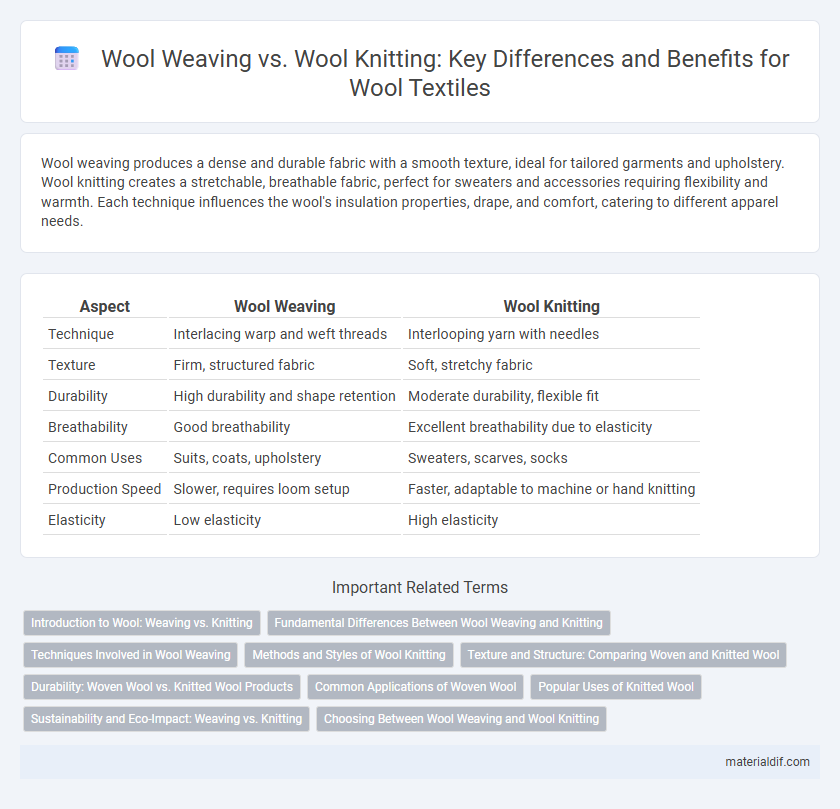Wool weaving produces a dense and durable fabric with a smooth texture, ideal for tailored garments and upholstery. Wool knitting creates a stretchable, breathable fabric, perfect for sweaters and accessories requiring flexibility and warmth. Each technique influences the wool's insulation properties, drape, and comfort, catering to different apparel needs.
Table of Comparison
| Aspect | Wool Weaving | Wool Knitting |
|---|---|---|
| Technique | Interlacing warp and weft threads | Interlooping yarn with needles |
| Texture | Firm, structured fabric | Soft, stretchy fabric |
| Durability | High durability and shape retention | Moderate durability, flexible fit |
| Breathability | Good breathability | Excellent breathability due to elasticity |
| Common Uses | Suits, coats, upholstery | Sweaters, scarves, socks |
| Production Speed | Slower, requires loom setup | Faster, adaptable to machine or hand knitting |
| Elasticity | Low elasticity | High elasticity |
Introduction to Wool: Weaving vs. Knitting
Wool weaving involves interlacing two sets of yarns at right angles to create a durable, structured fabric ideal for suiting and upholstery. Wool knitting loops yarn in a continuous series of interconnected stitches, producing flexible, stretchy textiles commonly used in sweaters and socks. Understanding the distinct techniques highlights wool's versatile applications and performance characteristics in woven versus knitted forms.
Fundamental Differences Between Wool Weaving and Knitting
Wool weaving interlaces two sets of yarns at right angles creating a firm, structured fabric, ideal for durability and tailored garments. Wool knitting loops a single yarn continuously, producing a stretchable and flexible textile commonly used for sweaters and scarves. These fundamental techniques influence the texture, elasticity, and application of wool fabrics in fashion and home textiles.
Techniques Involved in Wool Weaving
Wool weaving involves interlacing two sets of yarns at right angles: the warp (longitudinal threads) and the weft (horizontal threads), creating a firm and stable fabric ideal for durability and structure. This technique requires precise tension control and the use of a loom, enabling patterns such as twill, satin, or plain weave that enhance texture and strength. Compared to wool knitting, weaving produces less stretch but higher resistance to abrasion, making it suitable for outerwear and upholstery.
Methods and Styles of Wool Knitting
Wool knitting involves interlocking loops of yarn using needles or machines, creating flexible, stretchy fabrics ideal for garments like sweaters and scarves, whereas wool weaving uses two sets of threads woven perpendicular to each other, producing stiffer, more structured textiles suited for suits and blankets. Common styles of wool knitting include stockinette, ribbing, and cable knit, each providing unique textures and elasticity to wool products. Machine knitting enables mass production of uniform wool fabrics, while hand knitting allows intricate patterns and customized designs.
Texture and Structure: Comparing Woven and Knitted Wool
Woven wool features a tight, grid-like structure resulting in a firm texture with enhanced durability and shape retention, ideal for tailored garments and upholstery. Knitted wool showcases an interlooped pattern producing a stretchy, flexible fabric with a soft, airy texture suited for sweaters and thermal wear. The structural differences influence breathability, insulation, and comfort, making woven wool more rigid and knitted wool more elastic.
Durability: Woven Wool vs. Knitted Wool Products
Woven wool products exhibit superior durability due to their tightly interlaced fibers, providing enhanced resistance to wear and tear compared to knitted wool. The structured grid of woven wool minimizes stretch and distortion, maintaining garment shape over time. Knitted wool, while more flexible and breathable, tends to be less durable as its looped construction is more susceptible to snagging and fabric deformation.
Common Applications of Woven Wool
Woven wool is commonly used in tailored garments like suits, coats, and trousers due to its structured and durable fabric properties. Its tight interlacing pattern provides stability and resistance to stretching, making it ideal for formal wear and upholstery. The material's smooth texture and ability to hold sharp creases enhance its popularity in professional and classic fashion applications.
Popular Uses of Knitted Wool
Knitted wool excels in creating flexible, stretchy fabrics ideal for clothing items such as sweaters, scarves, and gloves, offering warmth and comfort in cold weather. Wool weaving produces denser, more durable textiles suitable for upholstery and coats, but knitted wool remains popular for activewear and casual garments due to its breathability and elasticity. The versatility of knitted wool makes it a preferred choice for layering pieces and intricate patterns in fashion.
Sustainability and Eco-Impact: Weaving vs. Knitting
Wool weaving typically uses less energy and generates less waste compared to wool knitting, making it a more sustainable textile production method. The tightly interlaced structure of woven wool enhances durability, reducing the need for frequent replacement and lowering long-term environmental impact. Wool knitting, while offering flexibility and comfort, often involves greater resource use and can result in more offcuts, increasing its overall ecological footprint.
Choosing Between Wool Weaving and Wool Knitting
Wool weaving produces a dense, sturdy fabric ideal for structured garments like coats and upholstery, offering durability and a smooth finish. Wool knitting creates stretchy, breathable textiles suited for flexible clothing such as sweaters and scarves, ensuring comfort and insulation. Choosing between wool weaving and knitting depends on the desired texture, stretch, and end-use of the wool product.
Wool Weaving vs Wool Knitting Infographic

 materialdif.com
materialdif.com